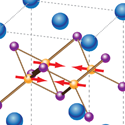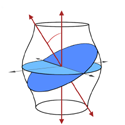Michael R. Norman
High-temperature superconductivity in the iron pnictides
A new class of high-temperature superconductors has been discovered in layered iron arsenic compounds. Results in this rapidly moving field may shed light on the still unsolved problem of high-temperature cuprate superconductivity. Read More »
Fermi-surface reconstruction and the origin of high-temperature superconductivity
After twenty years of effort, definitive quantum oscillations that could be used to map the Fermi surface were finally observed in a high-temperature cuprate superconductor in 2007. This and subsequent studies reveal a profound rearrangement of the Fermi surface in underdoped cuprates. The cause of the reconstruction, and its implication for the origin of high-temperature superconductivity, is a subject of active debate. Read More »
Superconductivity with a Twist
The discovery of superconductivity in a manganese-based “helical” magnet opens a new path to explore the relationship between superconductivity and magnetism. Read More »
Entering the Nickel Age of Superconductivity
After a 30-year quest, researchers found a nickel-based analog of copper oxide superconductors. The discovery motivates the search for other nickelates and should provide new insights into the origin of high-temperature superconductivity. Read More »






